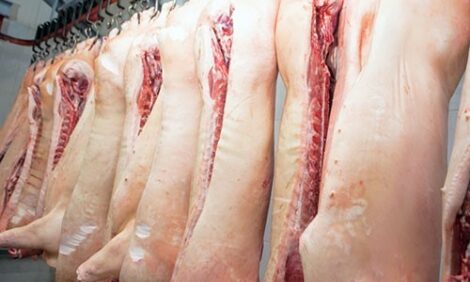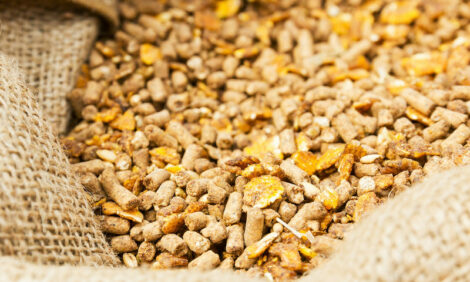



US pig farmers face $5 billion losses and oversupply issues amid COVID-19 pandemic
At a press briefing (14 April), the National Pork Producers Council (NPPC) outlined the crisis as described by producers and the immediate relief they are requesting from the administration and Congress.The impact of COVID-19 has caused hog values to plummet, creating a financial disaster for pork producers nationwide who face a collective $5 billion loss for the remainder of the year, reports the NPPC.
“We remain committed to supplying Americans with high-quality US pork, but face a dire situation that threatens the livelihoods of thousands of farm families,” said NPPC President Howard “A.V.” Roth, a pork producer from Wauzeka, Wisconsin. “We are taking on water fast. Immediate action is imperative, or a lot of hog farms will go under.”
The suspension of pork packing plant operations and rising employee absenteeism due to COVID-19 has exacerbated an existing harvest facility capacity challenge due to a labour shortage in rural America. With limited harvest capacity, a surplus of pigs exists, causing hog values to plunge. The loss of the food services market (i.e. restaurants) and the COVID-related slowdown in most export markets has crashed demand and overwhelmed the cold storage of meat.
The National Pork Producers Council is now calling for immediate government intervention to sustain a farm sector essential to the US food supply.
Current market analysis
Dr Dermot Hayes, an economist with Iowa State University, and Dr Steve Meyer, a pork industry economist with Kerns & Associates, estimate that hog farmers will lose nearly $37 per hog, or almost $5 billion collectively, for each hog marketed for the rest of the year. Prior to the COVID-19 crisis, and after two challenging years, hog farmers were generally expecting a profitable year, with industry analysts forecasting earnings of approximately $10 per hog on average for 2020.
"We are now a farm sector in dire crisis," said Roth.
"Farmers are already exiting the business and the damage will worsen without immediate government intervention.
"Producers need over one billion in pork purchases by the USDA to clear out a backed-up meat supply, supplementing the agency's food bank programmes facing increased demand due to rising unemployment and direct payments to producers without eligibility restrictions."
Roth added, “The pork industry is based on a just-in-time inventory system. Hogs are backing up on farms with nowhere to go, leaving farmers with tragic choices to make. Dairy producers can dump milk. Fruit and vegetable growers can dump produce. But, hog farmers have nowhere to move their hogs.”
NPPC, in consultation with hog farmers across the nation, identified several measures it has raised with federal policy makers, including:
- Over $1 billion in pork purchases by the USDA to clear out a backed-up meat supply, supplementing agency food bank programmes facing increased demand due to rising unemployment. These purchases should accommodate pork products packaged for restaurants and other segments of the food services market.
- Equitable direct payments to producers participants without eligibility restrictions.
NPPC is also seeking a legislative fix to emergency loan programmes that have left farmers behind. Approximately 10,000 family hog farms are in jeopardy because they do not have access to much-needed capital offered by the Small Business Administration. NPPC urges Congress to increase the cap on qualifying businesses to those that employee up to 1,500 and to make agricultural businesses eligible for the Economic Injury Disaster Loan programme.
The economic impact analysis by Dr Hayes and Dr Meyer was based on live hog futures between 10 March to 10 April.
Trump administration facing pressure to buy food for the needy
The Trump administration is facing mounting pressure to buy more meat, dairy and produce for food banks as farmers destroy agricultural goods due to reduced restaurant demand. Rabobank estimates that overall North American meat demand is down some 30 percent in the past month, reports Reuters.
Increased food purchases by USDA can "help ensure that the production that no longer has a foodservice market can be made available to help our nation's food banks," said Representative Collin Peterson, chairman of the House Agriculture Committee.
Peterson, in a letter on Tuesday (14 April), urged USDA Secretary Sonny Perdue to use $9.5 billion in funding through the CARES Act relief bill, as well as the Commodity Credit Corporation funding authority, to ease food demand disruptions from the outbreak.
Perdue said on Twitter last week USDA is developing a programme that will include direct payments to farmers and "procurement methods to help solidify the supply chain from producers to consumers." The agency said on Tuesday that details will be released soon.
Feeding America, which says it is the largest US hunger-relief organisation, and the American Farm Bureau Federation said in a letter last week that USDA should implement a voucher programme that would allow farmers and food banks to work directly with one another.
"We are seeing literally tonnes of agricultural goods being discarded because of the shutdown of so much of the economy," the letter said. "Paradoxically, we are seeing a simultaneous surge in demand at a moment when many farmers are being told there is an oversupply of their product."








